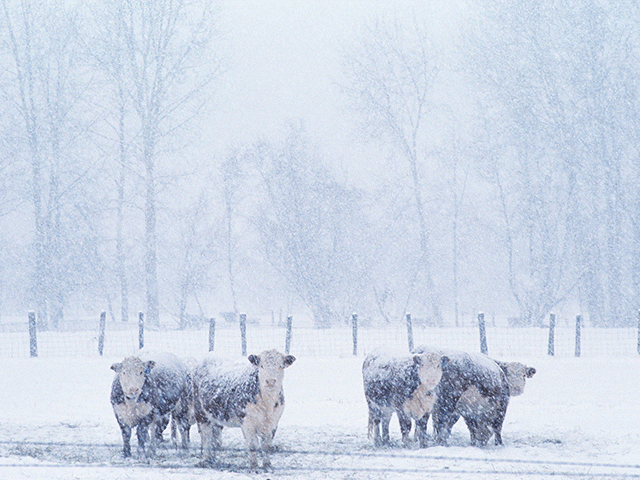Polar Vortex Cold Affects Cattle
Extreme Cold From Polar Vortex Leads to Cattle Risks
OMAHA (DTN) -- Winter finally feels like winter with extremely cold weather this week in the Northern Plains and across the border into the Canadian Prairies. Another polar vortex is set to move into the middle of the U.S. next week, according to meteorologists.
With these cold conditions, livestock producers should plan accordingly and implement certain management practices to protect their animals. These procedures range from moving livestock to shelter to altering feed requirements.
COLD WEATHER INVADES
The first round of cold air has been seen this week across the Canadian Prairies and down into the Northern Plains and northern Midwest, according to DTN Ag Meteorologist John Baranick.
Temperatures in the Canadian Prairies and just across the U.S. border will struggle to get above zero degrees Fahrenheit this week. Nighttime temperatures have been in the minus 20 to minus 30 Fahrenheit range for the past few days, he said. Wind chills led to some places feeling equivalent to minus 40s and even minus-50s F.
Baranick said the regions will get a break from the bitter cold at the beginning of next week, but then round two of the polar vortex moves into the middle of the country midweek. It is still early, so getting temperature forecasts correct is tough, but it does look similar for the Prairies and Northern Plains to see sub-zero temperatures once again, he said.
"But the rest of the country looks like it will get in on the cold action as well," Baranick said. "We are not anticipating sub-zero highs anywhere else just yet; but sub-zero lows across the Central Plains through the Midwest do look possible for several nights in a row."
Baranick said the main question for now is how long will this cold weather last. Models cannot come to an agreement on when the cold ends for the Central Plains and Midwest, but most areas are likely to only have a few days of it, he said.
The Canadian Prairies and the Northern Plains, however, are not as fortunate. Models do not believe the cold air will be leaving this region anytime soon, Baranick said, and it looks to be a long-haul, even for this portion of North America.
BELOW NORMAL FOR FEBRUARY IN MIDWEST
P[L1] D[0x0] M[300x250] OOP[F] ADUNIT[] T[]
Longer term, Baranick said below-normal temperatures are forecast through the end of February for the Midwest. That does not mean it will be consistently cold as there could be breaks in the pattern; but an overall cold rest of the winter appears likely.
"That, of course, is indicative of La Nina in North America; but the length of the cold pattern is a bit extreme," he said. "We usually see some extended breaks of a few weeks before the artic temperatures come back into the region, but this year it is not looking that way."
LIVESTOCK PRODUCERS: PLAN FOR COLD
Livestock producers in areas with extremely cold weather need to consider cold weather practices to protect their animals. Colorado State University (CSU) Extension has an extensive list of severe cold weather considerations that can be found at https://extension.colostate.edu/….
The CSU report suggested moving livestock before or at the onset of extreme winter weather. For short durations, landscape topographic features such as ravines, canyons, draws and natural windbreaks may be sufficient protection from the elements.
Low temperatures without wind are usually not enough to affect the performance of animals. Wind alone can cause the same effect on animals as exposure to a sudden drop in temperature. A 20-mile-per-hour (mph) wind is roughly equivalent to a 30-degree drop in temperature.
Livestock producers should use shelter, sheds or windbreaks during low temperatures.
Windbreaks that are taller and more dense (have less openings) are more effective than other types of windbreaks. Windbreaks can be manmade or natural, generally trees.
Cattle in cold weather should have abundant and accessible feed, which will help them maintain body temperature and survive. Livestock will need extra feed in severe cold weather to maintain body temperature and body condition.
To see a former DTN story on feeding cattle and hogs during cold weather, see https://www.dtnpf.com/…) and for more on feeding cows for cold weather, see the University of Nebraska-Lincoln (UNL) newsletter https://newsroom.unl.edu/….
Maintaining livestock waterers is also critical during cold weather, and you can find an energy efficiency checklist and tips at https://www.dtnpf.com/….
WATCH BULLS TOO
The management of bulls is a critical component of winter livestock management, considering they contribute half the genetics to a cowherd. DTN wrote about this subject at the end of 2020 and you can see it at https://www.dtnpf.com/….
Bulls generally lose anywhere from 100 to 400 lbs. during the breeding season or about 10% to 15% of their body weight, research has shown. They need to regain the weight before the next breeding season and, for most producers, the time to put some weight back on bulls would be during the winter months.
Cold weather can have negative effects on the fertility of bulls. Cold weather and wind chill can result in bull infertility with tissue damage to the scrotum.
Frostbite lowers semen quality in bulls, according to studies. The soundness score of semen quality of bulls with frostbite can drop significantly.
Producers should utilize breeding soundness exams with their bulls. There are four components of the exam: a general physical exam, a scrotal circumference measurement, sperm motility and sperm morphology.
This breeding soundness exam should be done four to six weeks prior to the breeding season.
Russ Quinn can be reached at russ.quinn@dtn.com
Follow him on Twitter @RussQuinnDTN
(c) Copyright 2022 DTN, LLC. All rights reserved.





